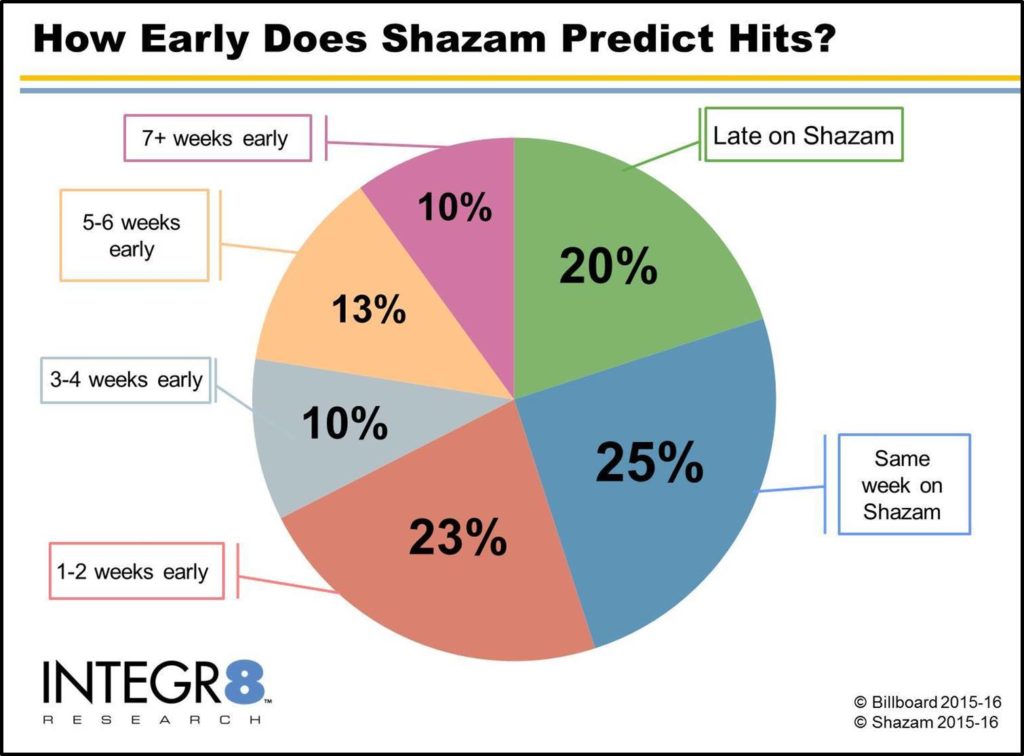How Shazam Can Help You Predict Hits:Part 1
How good is Shazam at predicting hits? When Shazam® emerged a few years ago, radio programmers quickly saw its potential as a hit-predicting oracle, and since then Shazam has grown so large that Mediabase® recently added market-specific Shazam data.
Shazam has a vested interest in fostering the perception that it predicts hits. Selling detailed data to record companies to guide their sales and windowing strategy is one of Shazam’s revenue streams. Shazam’s former chief technologist Jason Titus once claimed, “Sometimes we can see when a song is going to break out months before most people have even heard of it.”
It’s not hard to find anecdotal examples of artists that Shazam spotted first, which is why we’ve always encouraged our Integr8 New Music Research clients to use Shazam in conjunction with sales, streaming, format airplay and their own custom new music research to decide which new releases deserve the most exposure. However, no one has quantified how early and how often Shazam can spot tomorrow’s hits, or which future hits Shazam is most helpful at predicting.
So we did.
We examined which songs became Top 10 most “Shazamed” songs in the United States each week during 2015 and early 2016 and tracked which songs ultimately became hits on the Billboard® Hot 100 chart. The Hot 100 tracks physical and digital music sales, on-demand and pre-programmed streaming, and terrestrial radio airplay, which makes it the most complete metric of American’s music consumption to use for comparison with Shazam. We then analyzed:
- How many Top 10 Shazam songs went on to be Top 10 hits on the Hot 100—and how many didn’t?
- On average, how soon can Shazam spot a song’s potential before it becomes a Top 10 hit?
- Are there any particular kinds of hit songs Shazam does or does not spot early?
Here’s what we learned:
If a song reaches Shazam’s Top 10, there’s a 94% chance it will be a hit.
The vast majority of America’s Top 10 most Shazamed songs ultimately become hit songs, with the majority becoming big hits. Seventy-three percent (73%) of the songs that reach Shazam’s Top 10 also become a Top 10 hit on Billboard’s 100. Another 13% will reach the Top 20 and an additional 8% will become Top 30 hits on the Billboard Hot 100. Only 6% of songs that reach Shazam’s Top 10 never become Top 30 hits.
On average, Shazam predicts Top 10 hits two weeks early
Among the 73% of songs that reach Shazam’s Top 10 and also become Billboard Hot 100 Top 10 hits, Shazam’s lead time at spotting those hits early varies widely. For 45% of songs, Shazam mirrors or even lags behind the Billboard Top 100. In fact, 20% of songs reach the Hot 100’s Top 10 before they reach Shazam’s Top 10.
For the remaining 55% of songs, however, Shazam is early:
- Shazam’s claim that they can sometimes spot a hit, “months before most people have even heard of it,” is true for 10% of songs which become Top 10 on Shazam seven or more weeks before they become Top 10 hits on Billboard.
- Twenty-three percent (23%) are three to six weeks ahead on Shazam.
- Another 23% of Top 10 hits rise to Shazam’s Top 10 only one to two weeks early.
So on average, songs emerge as Top 10 hits on Shazam two weeks earlier than they do on Billboard’s Hot 100.
Clearly, the numbers show Shazam has potential to spot a significant percentage of hit songs early. The real question is, however, is there a pattern to the styles or genres of songs that Shazam can help you spot early? We’ll tackle that analysis with specific artist and titles in our next blog.



Pingback: Does Shazam Predict Radio Hits? - Radio Ink